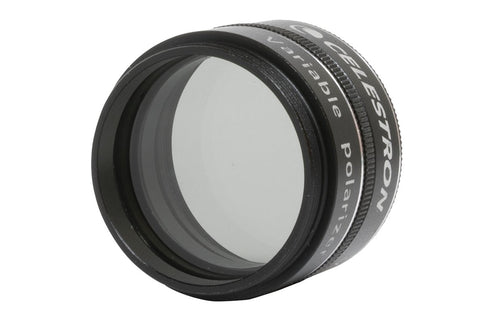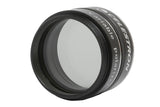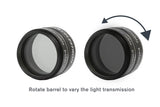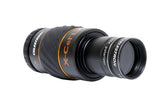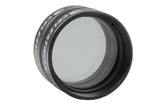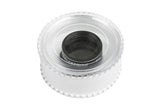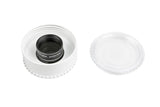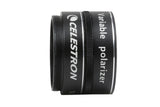Yes, our inventory is accurate!
![]() Qualifies Towards Free Ground Economy Shipping (CONUS Only) For Most Orders Of $149 Or More
Qualifies Towards Free Ground Economy Shipping (CONUS Only) For Most Orders Of $149 Or More
- A customizable way to reduce brightness and glare on the brightest celestial objects like the Moon, Venus, Saturn, Jupiter, Mars, and bright double stars
- Adjust the level of light transmission from 1-40% for the best possible view for your specific target and current viewing conditions
- Simple to use—just rotate filter’s lower ring to adjust brightness
- Threads onto any 1.25” eyepiece
Features
When you want to selectively reduce the brightness of celestial objects for a customized view, the Variable Polarizing Filter is the perfect choice. Unlike regular Moon Filters and Neutral Density Filters, the level of brightness can be reduced to just 1% or as much as 40%. To make the adjustment, simply rotate the filter’s lower ring and the image gets brighter or dimmer.
This filter does not alter the color of the object you’re observing, making it a great choice for astroimaging, especially when imaging the surface of the Moon. By reducing the brightness, lunar details become more pronounced and defined. This filter can also be used to darken the blue-sky background when hunting for planets like Venus or Jupiter in the daylight, making the planet stand out from the background.
The Variable Polarizing filter threads onto any Celestron 1.25” eyepiece. Lastly, the filter can be threaded on both sides so you can stack it with other filters, such as color or neutral density, if needed.
Instructions
For telescopes that use a diagonal (refractors, SCTs, and Maks), separate the variable polarizing filter into its two halves. Screw one half (it doesn't matter which half) onto the part of the diagonal that inserts into the telescope. Put the diagonal back into the telescope, using the thumbscrews to make sure that it is tightly in place.
Screw the other half of the filter onto the bottom of the eyepiece that you're using to observe. Put the eyepiece into the diagonal; however, don't use the thumbscrews to tighten the eyepiece in place. Instead, while you're observing, twist the eyepiece slowly to adjust the level of brightness to your liking, anywhere between 1% and 40% transmission.
For telescopes that don't use a diagonal (dobsonians/newtonians), keep the two halves of the filter together. Screw the filter as one piece onto the bottom of the eyepiece that you're using to observe. Put the eyepiece into the focuser. When you want to adjust the level of brightness, pull the eyepiece out of the focuser and give the bottom part of the filter a small twist, and then replace the eyepiece into the focuser.
Specifications
| Size diameter | 31.75mm (1.25") |
| Cell Housing | Aluminum cell housing |
| Stackable Filter | Yes |
| Light Transmission | Adjustable for large and small telescopes |
| Dimensions Filter only | 31.4mm x 22.4mm (1.23" x .88") |
| Dimensions Case only | 68mm x 28mm (2.67" x 1.1") |
| Dimensions Packaging | 72mm x 71mm x 33mm (2.83" x 2.8" x 1.3") |
| Weight Filter only | .56 oz (16 g) |
| Weight Case only | .91 oz (26 g) |
| Total Package Weight | 1.7 oz (50 g) |

